Madagascar in July imposed a prohibition on industrial trawlers fishing in waters within 2 nautical miles (3.7 kilometers) of the country’s coast.Small-scale fishers, who for years have clashed with the industrial vessels, welcomed the new rule, but say the trawlers are largely ignoring it.Vessel-tracking data appear to corroborate their claims, with at least 14 trawlers apparently fishing in the prohibited zone along the west coast in recent months.An industry executive said that any incursions by his company were uncommon and accidental. Regulators say penalties will be imposed based on the severity of the violations.
This is part two of a three-article series on industrial fishing in Madagascar’s waters. Part one focuses on offshore fishing; part three looks at changes to the near-shore trawling sector.
NOSY FALY, Madagascar — For decades, tensions have simmered between Madagascar’s small-scale fishers and the industrial trawlers that operate near the country’s coast. In 2017, the small-scale fishers called for an exclusive-access zone that would keep the trawlers away from the shore. This year, they got their wish, at least on paper: the government issued a regulation that prohibits industrial fishing within 2 nautical miles (3.7 kilometers) of the shore.
Civil society members celebrated the new regulation, which took effect July 1. The rule could help protect marine habitats and improve coastal livelihoods by increasing the amount of available fish and shrimp, experts say. However, they caution that enforcing the rule will be difficult — and indeed, there’s evidence that some trawlers may be violating it.
Trawlers still fish regularly within 2 nautical miles of Nosy Faly, a small island just off Madagascar’s northwest coast, fishers there told Mongabay.
“I see them every day,” said Gamal Ahmed, a Nosy Faly fisher and president of a regional fishers’ federation. “There has been no change. Even if this regulation came out, it didn’t change anything.”
A Réfrigépêche Ouest industrial fishing trawler fishes in the channel between Nosy Faly and Nosy Be. Image by Mongabay.
Tracking data supports Ahmed’s claim. Two trawlers appear to have fished for significant time periods within the 2-nautical-mile line around Nosy Faly in recent months, according to data from Global Fishing Watch (GFW), a nonprofit that publicly tracks fishing activity. At least 12 other vessels on the west coast, from multiple companies, also appear to have fished within 2 nautical miles of the shore. That’s the majority of vessels for which tracking data is publicly available, raising the possibility that rule-breaking is the norm rather than the exception. However, a lack of transparency about the exact contours of the prohibited zone makes it difficult to determine the legality of this close-to-shore fishing.
For the small-scale fishers of Nosy Faly, the possibility that trawling companies broke the rules is no surprise. “They don’t care about the rules and no one stops them even when they break the laws,” Noelson Rakotovao, a 35-year-old fisher and village leader on Nosy Faly, told Mongabay, referring to the trawlers. “When the trawlers work here, we go home with nothing.”
 Nosy Faly island, Madagascar. Image by Mongabay.
Nosy Faly island, Madagascar. Image by Mongabay. Roger Manoir, a local seafood dealer, selects the best of Nosy Faly’s small-scale fishers’ catch for sale. Image by Mongabay.
Roger Manoir, a local seafood dealer, selects the best of Nosy Faly’s small-scale fishers’ catch for sale. Image by Mongabay.
Violating the rule?
The two industrial trawlers that appear to have violated the rule near Nosy Faly are named Cap-St-Andre and Cap-Saint-Augustin. Cap-St-Andre fished clear around the island’s coast regularly from July 1 until Dec. 1, according to the GFW data, which is based on transmissions from vessels’ automatic identification systems (AIS). Cap-Saint-Augustin did not have its AIS transponder on for most of that time period, but did fish near Nosy Faly’s southeast coast in mid- and late July, when its transponder was on. (AIS isn’t the official compliance system used by Madagascar, but its use is required by international law, with some exceptions. The official compliance system doesn’t yield publicly available data.)
The two vessels belong to Réfrigépêche Ouest, a French-owned company that operates 10 vessels on Madagascar’s west coast. Réfrigépêche Ouest, together with Crustapeche, a sister company that it subsequently merged with, sold about $9 million in seafood to distributors in 2019, according to a company statement to Mongabay.
Réfrigépêche Ouest is a subsidiary of Groupe Réfrigépêche Madagascar (GRM), which is in turn part of an umbrella company called Groupe JMI, based in France. All of the companies are owned by the family of Guy Besnardeau, a 77-year-old French national who entered the fishing business in Madagascar in the 1980s. GRM exports shrimp to Europe, often selling under the brand name Gel-Pêche, another Groupe JMI company.
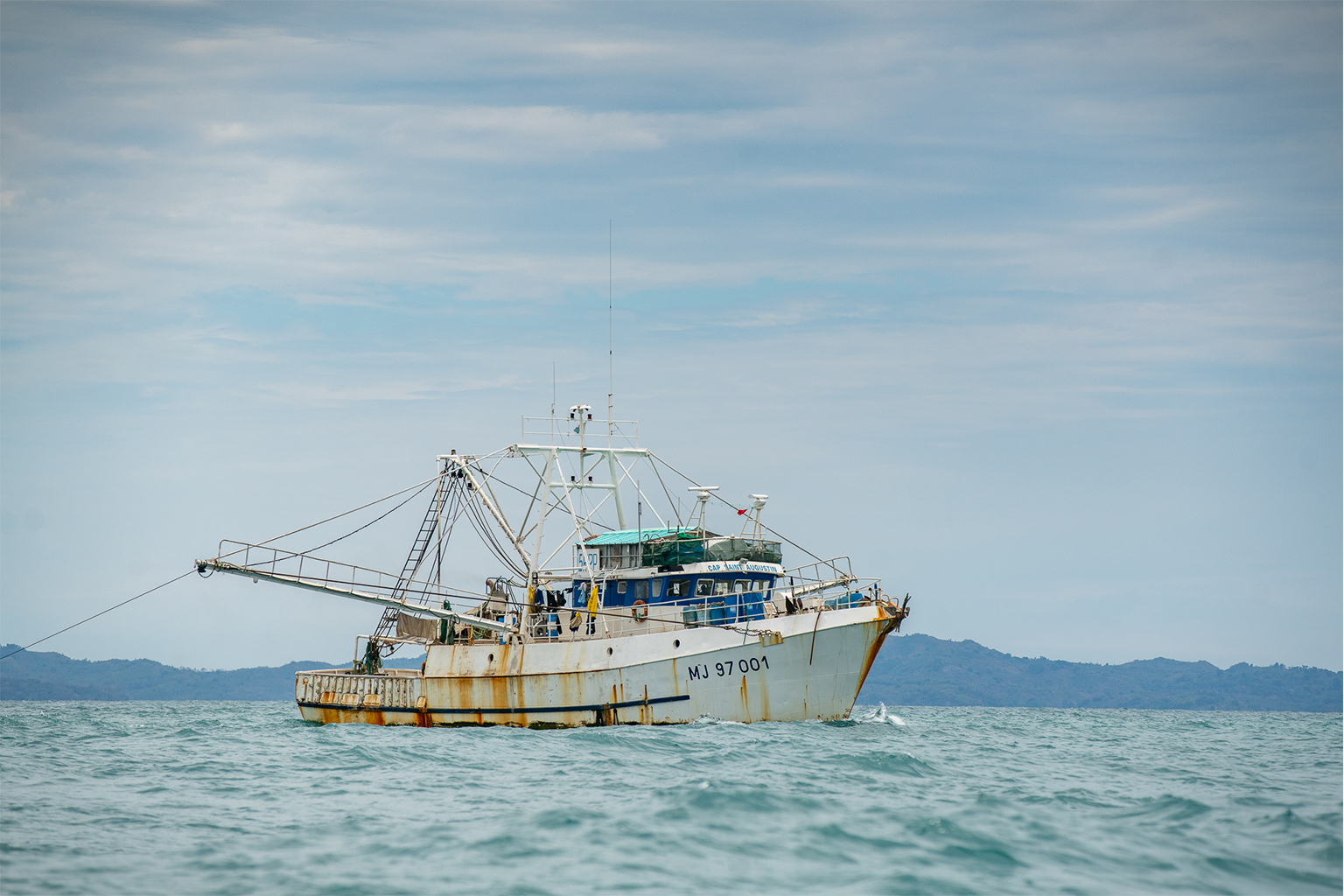 The fishing trawler Cap-Saint Augustin fishing off the shore of Nosy Faly. Image by Mongabay.
The fishing trawler Cap-Saint Augustin fishing off the shore of Nosy Faly. Image by Mongabay.
In a statement, Eric Douhéret, GRM’s chief operating officer, told Mongabay that the company respects the limits of the exclusion zone in northwest Madagascar and has received no feedback regarding noncompliance from the government authorities that track the vessels. “If there had been any penetration of restricted areas, it would obviously have been accidental and too occasional to have been deemed dangerous by the CSP [Centre de Surveillance des Pêches], who seriously monitors our positions, transmitted by beacon, and has observers on board our trawlers.”
Douhéret said the fisheries ministry had provided maps with GPS coordinates of the exclusion zone that did not conform exactly to the 2-nautical-mile limit cited in the regulation. “[S]ome limitations are beyond two miles and others are less than two miles, taking into account the peculiarities of the bay,” he wrote. However, he declined to share the maps or GPS coordinates with Mongabay, and ministry officials did not respond to questions about this matter.
The regulation, which was issued as article 15 of a ministerial decree, does not mention anything about maps or GPS coordinates. It specifies that the 2-nautical-mile measurement begins at the low-water mark and industrial fishing is prohibited in bays except where specifically allowed by a fisheries management plan. (After issuing the decree, the government changed the rule to 0.7 nautical miles, or 1.3 km, on Madagascar’s east coast; however, most nearshore fishing occurs on the west coast, where the 2-nautical-mile limit remains in effect.) There is a fisheries management plan in place in the northwest, but it makes no specific allowances for industrial fishing. Moreover, a “call for proposals” document the government issued privately to companies as part of the permit tendering process contained no reference to maps or GPS coordinates of the type Douhéret referenced.
Experts say more clarity and transparency is needed when developing exclusion zones. “The more detailed … the areas where the industrial fishing is banned, the better,” Salvador Fernández Bejarano, science officer at Flanders Marine Data Centre, which manages Marine Regions, a database of maritime boundary information, told Mongabay in an email. He said that, for example, the points at which bays begin and end should be demarcated.
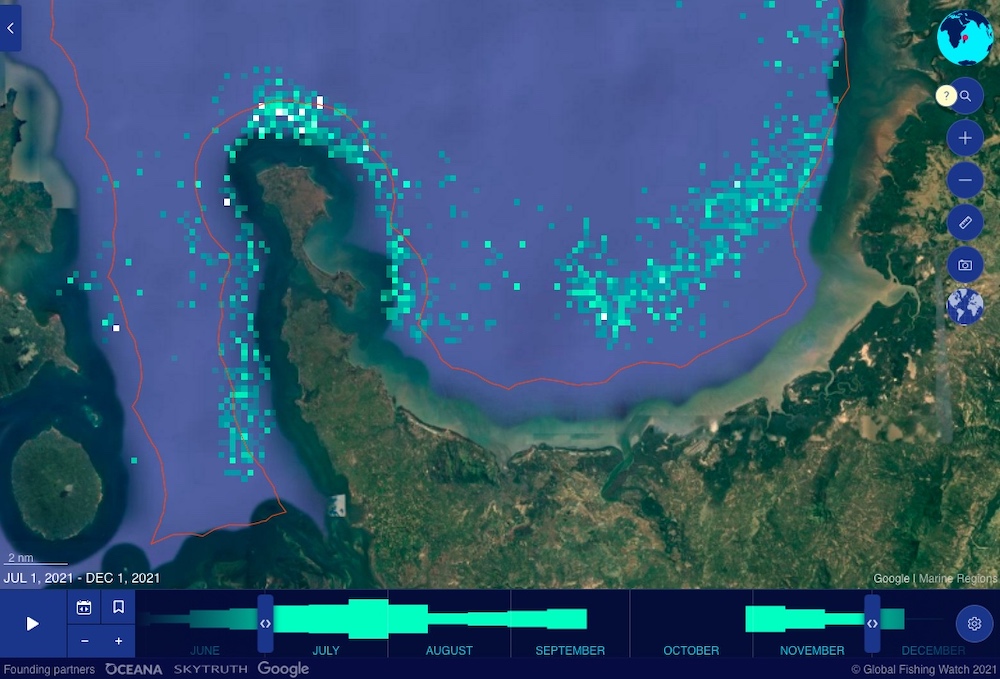 Apparent fishing activity by two industrial vessels, Cap-St-Andre (“Csa”) and Cap-Saint-Augustin, near Nosy Faly, an island just off the northwest coast of Madagascar, from July 1 to Dec. 1 of this year. This data indicate that the vessels may have entered a zone extending 2 nautical miles from the shore that has been reserved for small-scale fishers since July 1. The red line is an unofficial demarcation of the 2-nautical-mile limit, as developed by Global Fishing Watch (GFW) using Open Street Map data. No official demarcation of the zone has been released publicly by Madagascar’s government. Réfrigépêche Ouest, a French-owned company based in Madagascar, owns and operates the two vessels. Click the map to visit an interactive workspace on GFW’s website. Image courtesy of GFW.
Apparent fishing activity by two industrial vessels, Cap-St-Andre (“Csa”) and Cap-Saint-Augustin, near Nosy Faly, an island just off the northwest coast of Madagascar, from July 1 to Dec. 1 of this year. This data indicate that the vessels may have entered a zone extending 2 nautical miles from the shore that has been reserved for small-scale fishers since July 1. The red line is an unofficial demarcation of the 2-nautical-mile limit, as developed by Global Fishing Watch (GFW) using Open Street Map data. No official demarcation of the zone has been released publicly by Madagascar’s government. Réfrigépêche Ouest, a French-owned company based in Madagascar, owns and operates the two vessels. Click the map to visit an interactive workspace on GFW’s website. Image courtesy of GFW.
Industry representatives haven’t openly opposed the 2-nautical-mile rule but it’s easy to see why they might prefer not to follow it. A sizable portion of their catch has historically come from within this zone, though exactly how sizable has been a subject of debate and depends on where exactly the zone begins. Estimates have varied greatly, from 15 to 85%.
If Réfrigépêche Ouest has violated the rule, it’s not alone. At least 14 vessels from different companies appear to have fished in the zone in recent months, GFW data indicate. They represent at least 40% of the vessels fishing the west coast, which number 35 at most. These industrial incursions are concentrated in certain areas, such as near Belo Tsiribihina, a town in the southwest, and Cape Saint Andre, in the lower northwest.
 Apparent fishing activity by industrial fishing vessels from multiple companies, in an area between Cape Saint Andre and the city of Mahajanga in northwestern Madagascar, from July 1 to Dec. 1, 2021. Much of the activity inside the 2-nautical-mile limit on this map is by Zova 4 and Zova 5, vessels owned by Somapeche, a Chinese-owned company based in Madagascar. Four other Somapeche vessels also fished near the shore in this area, according to a GFW analysis, but this map does not record their fishing effort because they incorrectly reported their automatic identification system (AIS) positions, a practice known as spoofing that can be accidental or intentional. The red line is an unofficial demarcation of the 2-nautical-mile limit, as developed by GFW using Open Street Map data. No official demarcation of the zone has been released publicly by Madagascar’s government. Image courtesy of GFW.
Apparent fishing activity by industrial fishing vessels from multiple companies, in an area between Cape Saint Andre and the city of Mahajanga in northwestern Madagascar, from July 1 to Dec. 1, 2021. Much of the activity inside the 2-nautical-mile limit on this map is by Zova 4 and Zova 5, vessels owned by Somapeche, a Chinese-owned company based in Madagascar. Four other Somapeche vessels also fished near the shore in this area, according to a GFW analysis, but this map does not record their fishing effort because they incorrectly reported their automatic identification system (AIS) positions, a practice known as spoofing that can be accidental or intentional. The red line is an unofficial demarcation of the 2-nautical-mile limit, as developed by GFW using Open Street Map data. No official demarcation of the zone has been released publicly by Madagascar’s government. Image courtesy of GFW.
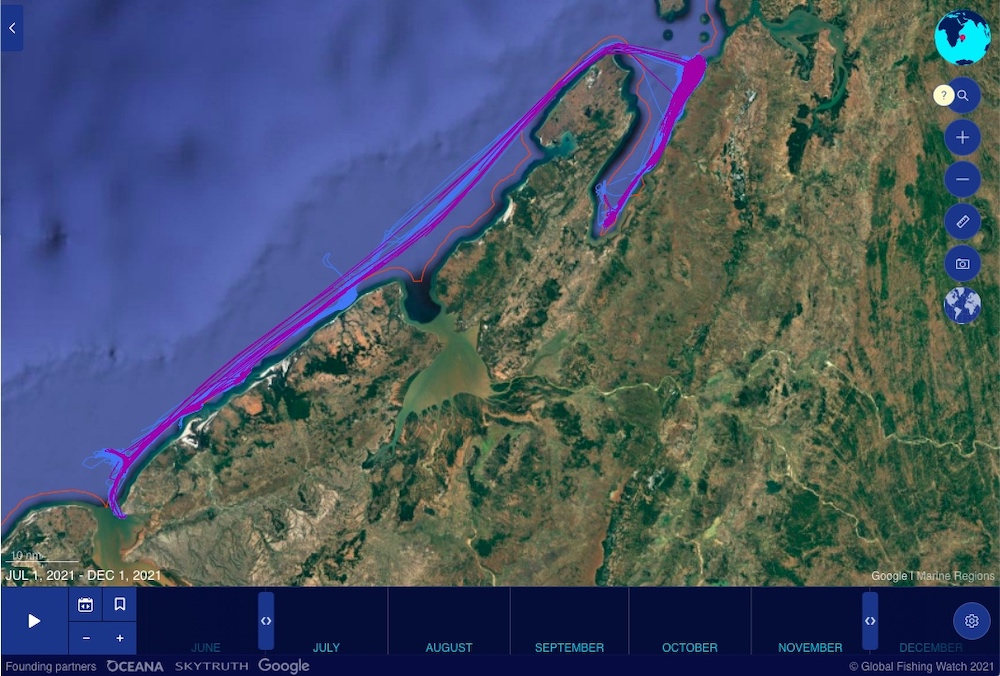 Tracks of two industrial trawlers, Jonobe 2 (blue) and Menabe 8 (purple), in an area northeast of the city of Mahajanga between July 1 and Dec. 1, 2021. A GFW analysis corrected for AIS spoofing and identified apparent fishing activity within 2 nautical miles of the shore, in possible violation of a regulation designed to protect small-scale fishing interests. Somapeche, a Chinese-owned company based in Madagascar, owns and operates the two vessels, as well as others that fished close to the shore along other parts of the coast. The red line is an unofficial demarcation of the 2-nautical-mile limit, as developed by GFW using Open Street Map data. No official demarcation of the zone has been released publicly by Madagascar’s government. Click the map to visit an interactive workspace on GFW’s website. Image courtesy of GFW.
Tracks of two industrial trawlers, Jonobe 2 (blue) and Menabe 8 (purple), in an area northeast of the city of Mahajanga between July 1 and Dec. 1, 2021. A GFW analysis corrected for AIS spoofing and identified apparent fishing activity within 2 nautical miles of the shore, in possible violation of a regulation designed to protect small-scale fishing interests. Somapeche, a Chinese-owned company based in Madagascar, owns and operates the two vessels, as well as others that fished close to the shore along other parts of the coast. The red line is an unofficial demarcation of the 2-nautical-mile limit, as developed by GFW using Open Street Map data. No official demarcation of the zone has been released publicly by Madagascar’s government. Click the map to visit an interactive workspace on GFW’s website. Image courtesy of GFW.
The most regular violator of the 2-nautical-mile rule appears to be Somapeche, a firm registered in Madagascar but ultimately owned by China National Agricultural Development Group Corporation, a state-owned Chinese company. At least eight of its 14 vessels have fished within 2 nautical miles of the west coast since the rule took effect in July, the GFW data show. Somapeche did not respond to Mongabay’s requests for comment for this story.
Andrianaivonavalona Rakotoniaina, a CSP division chief, told Mongabay that some vessels had fished in the exclusion zone and the CSP had responded. “[A]s soon as an area incursion has been detected and signaled by the system, a warning or a call to order has been sent against the vessel concerned and its owner,” Rakotoniaina told Mongabay by email. The CSP is compiling an annual report in which the infractions will be listed, he said.
The CSP’s role is to work with the companies to make sure they fulfill their responsibilities, Rakotoniaina said. “We are not the cat, or the bad wolf, who catches the mouse every time the latter commits an offense, but it is to prevent the mouse from doing stupid things. (Excuse me for the term.)”
Asked by this reporter if companies will be penalized for infractions, Rakotoniaina said, “You always insist on [asking about] the penalty, but you must always understand that management of the fishery and good governance are not easy things. The penalties will apply, of course, but that depends on the degree of the offense committed and in accordance with the regulations. There are administrative penalties such as non-renewal of the license, there are financial penalties, etc. Don’t worry, this is our country and the resources belong to us and it is up to us to manage them. We are not going to wait for others to take action, we are all aware.”
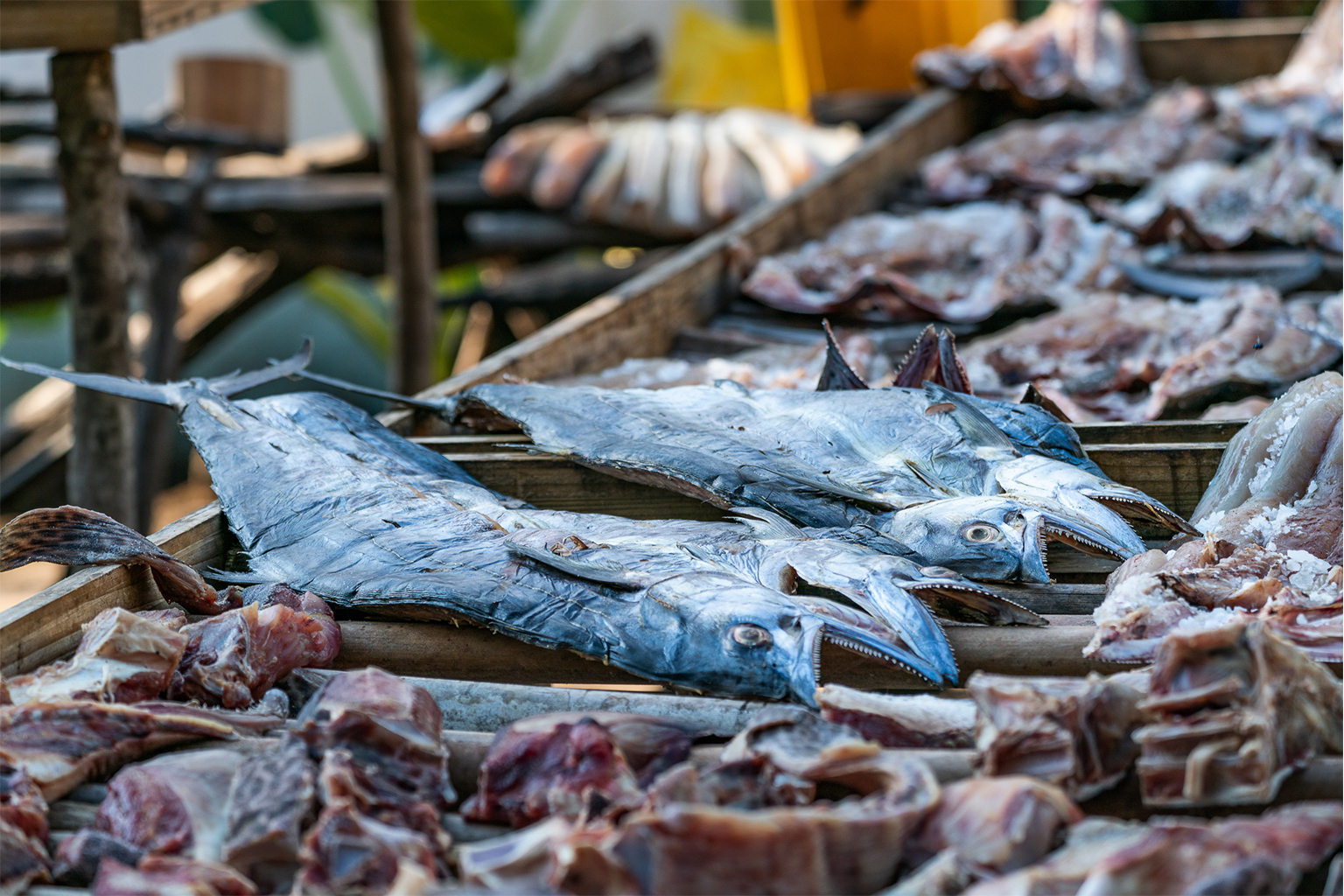 Fish and ray meat being dried and salted for sale on Nosy Faly. Image by Mongabay.
Fish and ray meat being dried and salted for sale on Nosy Faly. Image by Mongabay.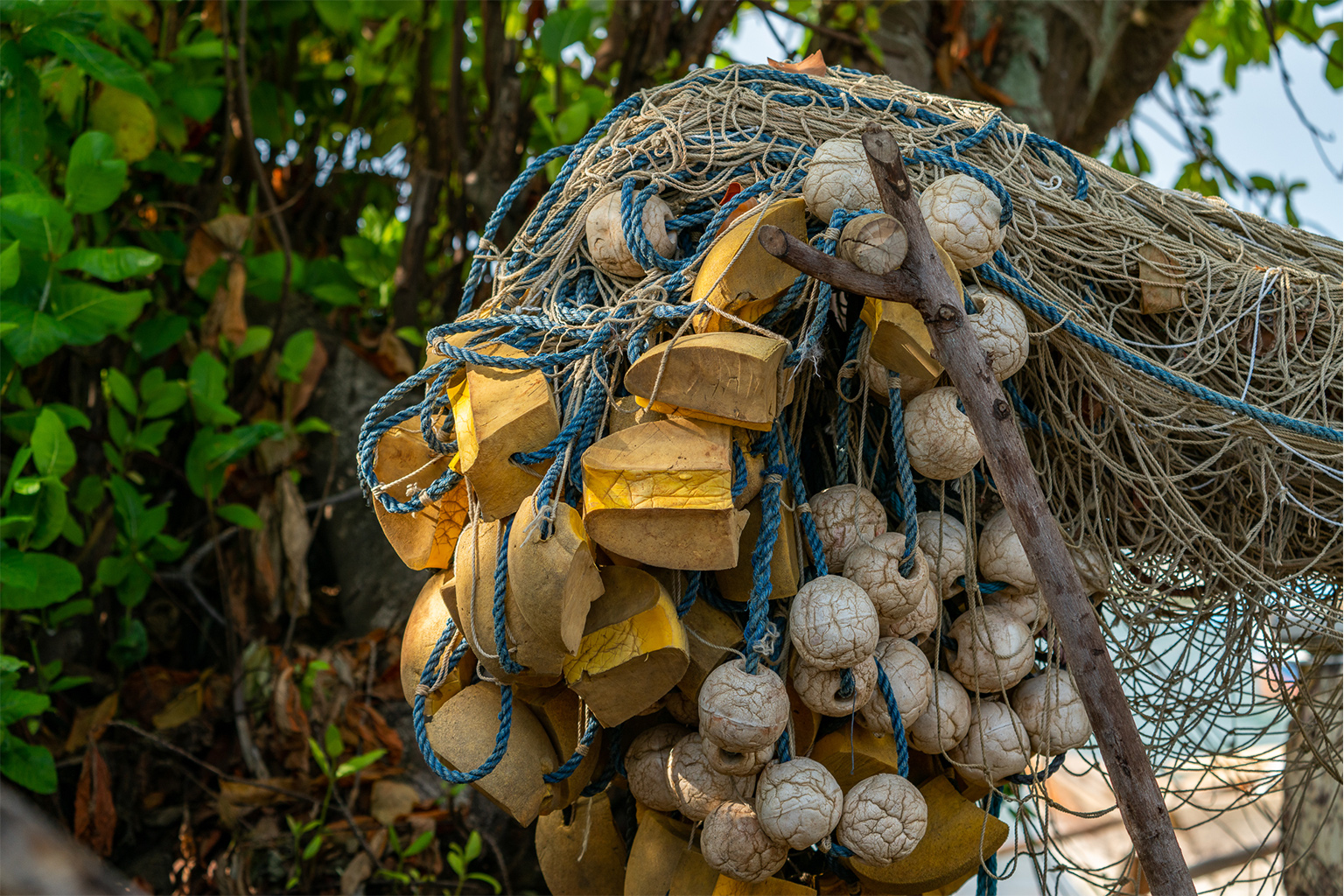 Small-scale fishers’ nets on Nosy Faly. Image by Mongabay.
Small-scale fishers’ nets on Nosy Faly. Image by Mongabay.
Local frustration
Hundreds of thousands of local people fish Madagascar’s waters, and industrial fishing has a large impact on their livelihoods. The shrimp fishery partially collapsed in the early to mid-2000s and has not recovered. Indian white prawn (Fenneropenaeus indicus) catches went down drastically, indicating a probable decline in population numbers. Observers dispute the reasons for the collapse, with some blaming the destructive techniques of small-scale fishers and others blaming decades of intensive trawling, which not only scoops up lots of shrimp but drags heavy equipment across the seafloor, disrupting habitat necessary for stocks to replenish.
As shrimp catches declined, Madagascar’s trawling firms shifted to catching more fin fish: more than a fourfold increase from 2008 to 2017, according to a 2019 report commissioned by SWIOFish2, a World Bank initiative. This pushed them into more direct competition with small-scale fishers.
The shrimp collapse was particularly bad in the northwest, where experts have called the shrimp fishery “economically extinct,” and this may have heightened conflict over remaining resources in places like Nosy Faly.
 Noelson Rakotovao helps to repair small-scale fishers’ nets on Nosy Faly. Image by Mongabay.
Noelson Rakotovao helps to repair small-scale fishers’ nets on Nosy Faly. Image by Mongabay.
The matter of industrial fishing stirs emotions on the coast not just because of direct competition over marine resources, but also because of an unequal distribution of power. Small-scale fishers express frustration that they have limited influence in government decisions about trawling. Meanwhile, at sea, they say they aren’t treated well by the fishing companies, whose vessels tower over their wooden pirogues, the vast majority of which are powered only by canvas sails.
“When we signal to them [the trawlers] that we are working here, they don’t care,” Rakotovao, the village leader, said. “It’s like we don’t exist to them. They think they are the boss of the ocean.”
“When our equipment gets caught by their vessel and we ask for it back they just tell us to go away. So we return home empty-handed and lose our jobs, as they prevent us from earning a living,” he said.
Roger Manoir, a 50-year-old seafood dealer who buys from small-scale fishers in Nosy Faly, also raised the issue of lost equipment. He said industrial vessels often unapologetically destroy local fishers’ nets and longlines.
“The trawlers never accept that they are at fault,” Manoir told Mongabay. “I’ve never seen them come to negotiate if they have destroyed the fishing gear of the local fishers. I have sent the fishers to talk with them but the trawlers don’t want to discuss it.”
The locals Mongabay interviewed did not mention Réfrigépêche Ouest by name, but it’s the only company currently licensed to fish around Nosy Faly, so its vessels may have been the source of their frustration. Douhéret said the company has a good relationship with small-scale fishers and reaches amicable resolutions to any incidents, which he said are rare. He said Réfrigépêche Ouest and other trawling firms have engaged with representatives of small-scale fishers; as an example, he cited a two-day conference in July 2019. He said the industry and small-scale fishers share the same resources and face the same threats.
“The highlighting of a conflict between industrial fishing and small-scale fishers seems to be a false problem, often instrumentalized,” he said.
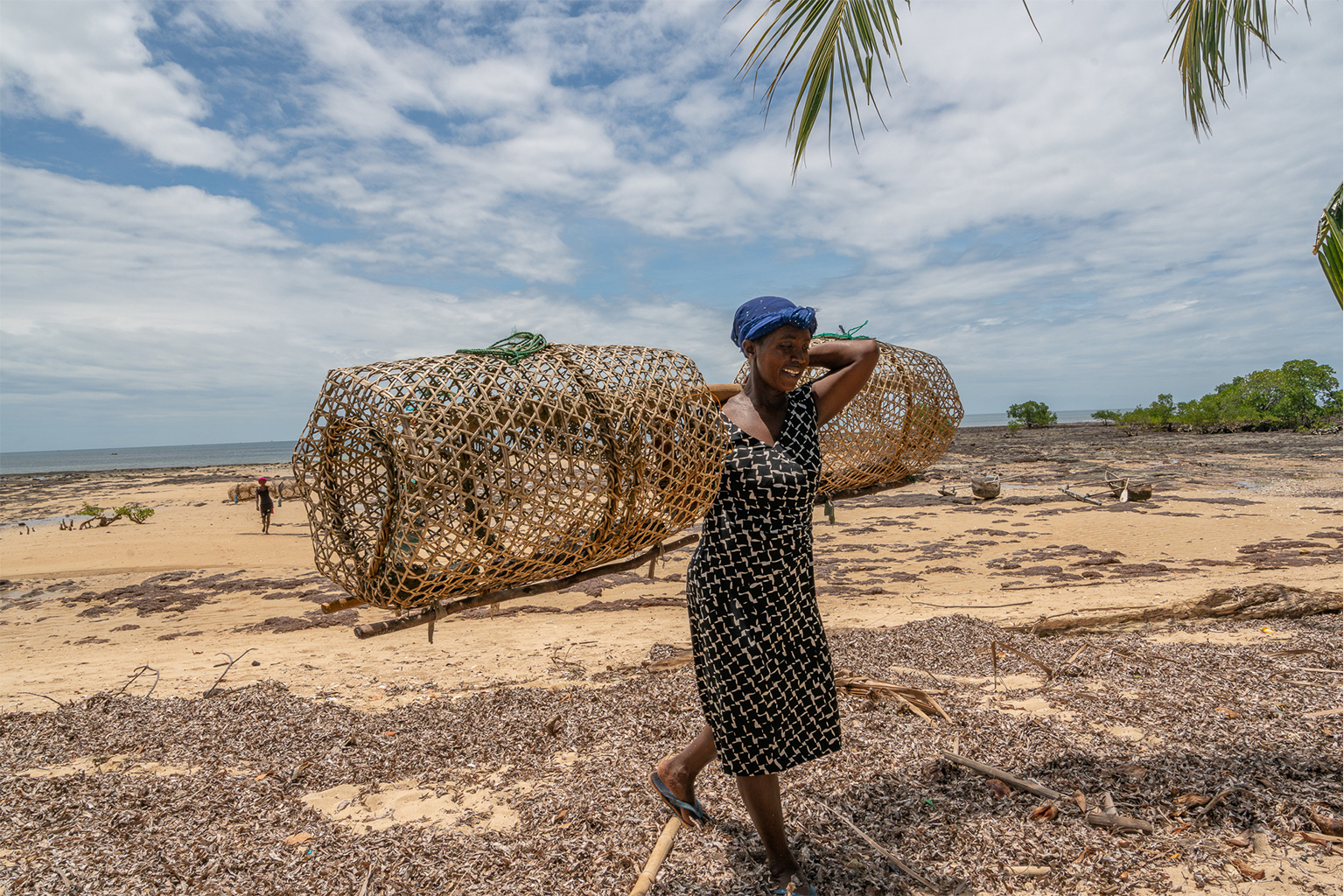 Martine Safarany, a 41-year-old fisher, retrieves her fish traps at low tide on Nosy Faly. Image by Mongabay.
Martine Safarany, a 41-year-old fisher, retrieves her fish traps at low tide on Nosy Faly. Image by Mongabay.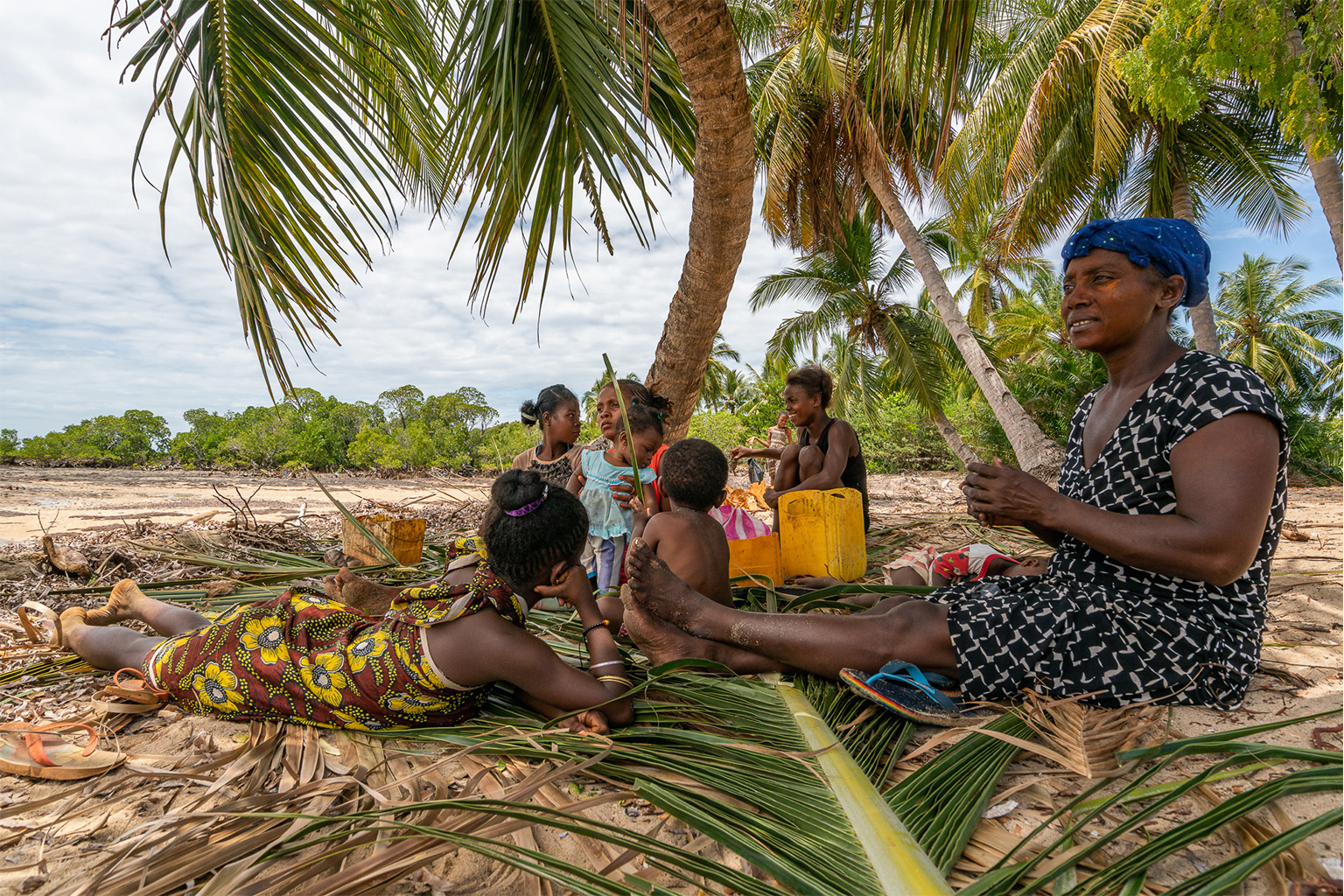 Martine Safarany relaxes with her family and other small-scale fishers in the shade of a tree on Nosy Faly. Image by Mongabay.
Martine Safarany relaxes with her family and other small-scale fishers in the shade of a tree on Nosy Faly. Image by Mongabay.
Whatever the role of industrial fishing, small-scale fishers now face monumental challenges. They work harder to try to make up for declining resources, going out earlier in the morning, according to Ahmed, the fishers’ federation president. Yet it’s not enough, as seafood catches have continued to decline, he and other locals said.
“Before I used to catch in my trap 8 or 10 kilograms [per day]” — about 18-22 pounds — “but nowadays I catch only 3 kilograms or only 1 kilogram,” or 2-7 lbs, Martine Safarany, a 41-year-old who has trapped fish in Nosy Faly for the last eight years, told Mongabay.
For the fishing communities of Nosy Faly, the struggle to catch enough to survive requires nothing short of establishing and maintaining exclusive fishing rights in coastal waters; half measures just won’t work, they said.
“These trawlers must not work so close to shore because they disturb the place where the fish congregate,” Manoir, the local seafood dealer, said. “This causes the fish to move away. We have to fight to find a solution to these problems. Otherwise the poor will become poorer and they will never be able to rise up.”
Global Fishing Watch, an international nonprofit focused on ocean governance and fisheries transparency, provided analytical support for this article. C4ADS, a Washington, D.C.-based nonprofit that built Triton, a fisheries transparency platform, helped research the ownership structures of companies mentioned in the article.
Banner image: Small-scale fishers on Nosy Faly carry their catch to sale. Image by Mongabay.
FEEDBACK: Use this form to send a message to the editor of this post. If you want to post a public comment, you can do that at the bottom of the page.
Business, Community Development, Conflict, Conservation, Environment, Environmental Law, Environmental Politics, Fish, Fisheries, Fishing, Food Industry, Governance, Human Rights, Illegal Fishing, Industry, International Trade, Law, Law Enforcement, Marine, Marine Conservation, Natural Resources, Oceans, Overfishing, Resource Conflict, Saltwater Fish
Africa, East Africa, Madagascar
Source link : https://news.mongabay.com/2021/12/madagascars-small-fishers-cheer-new-trawl-free-zone-but-do-trawlers-obey-it/
Author :
Publish date : 2021-12-28 08:00:00
Copyright for syndicated content belongs to the linked Source.





